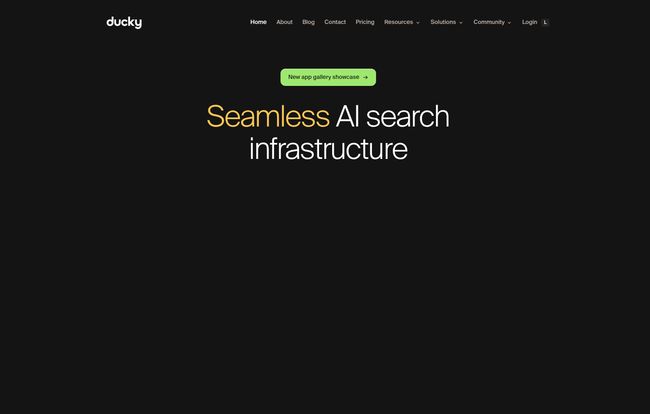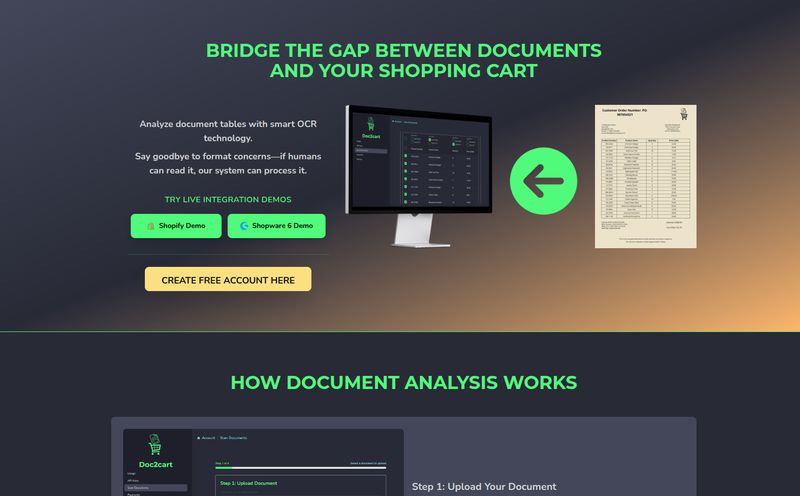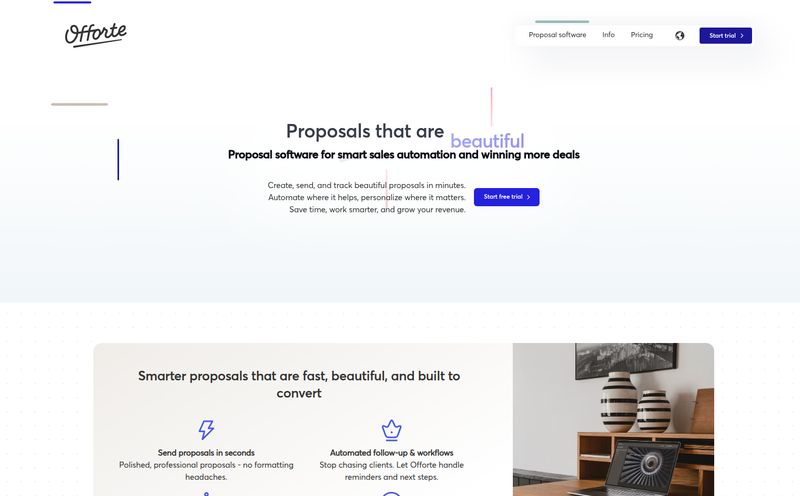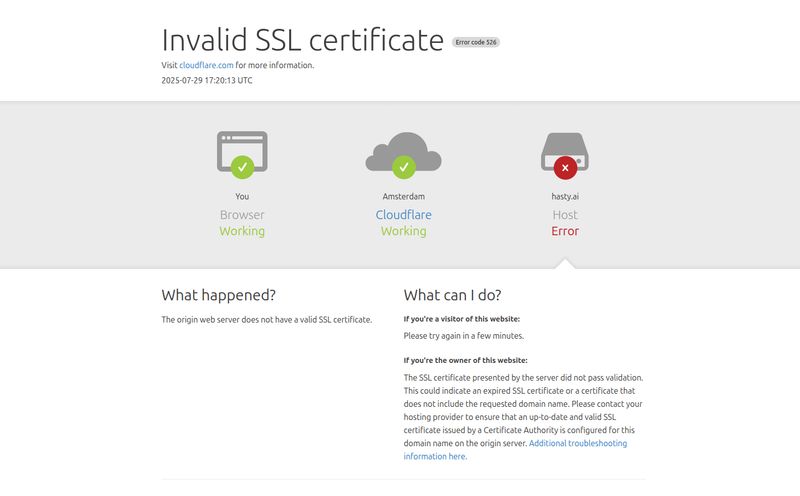If you’ve spent any time in the AI development space lately, you’ve heard the term RAG—Retrieval-Augmented Generation—about a million times. It's the secret sauce that makes LLMs actually useful by feeding them relevant, up-to-date information. But let’s be honest, building a good RAG pipeline is a massive pain. You’re juggling vector databases, choosing the right embedding models, figuring out reranking... it's a full-time job.
Frankly, I’ve sunk more hours than I’d like to admit into debugging a self-hosted search system that was supposed to be “easy.” So when I stumbled upon a platform named Ducky, I was skeptical but intrigued. The name is fun, and their website promises “Seamless AI search infrastructure.” A bold claim. But after kicking the tires, I gotta say, they might be onto something big.

Visit Ducky
So, What Exactly is Ducky AI?
In the simplest terms, Ducky is a fully managed AI retrieval service. Think of it as your RAG pipeline on-demand. Instead of you having to build the entire complex engine for your AI app to find and use information, Ducky handles it all for you. It’s designed specifically for developers who want to add powerful semantic search to their applications without getting bogged down in the MLOps nightmare.
The core idea is to abstract away the complexity. You don't have to pick a vector DB. You don't have to fine-tune an embedding model. You just send your documents to Ducky, and when you need to ask a question, you ask Ducky. It finds the most relevant snippets and hands them back to you, ready to be stuffed into your LLM prompt. It's like ordering a gourmet meal kit instead of having to raise the cow yourself. You still get to do the fun part—cooking the final dish (building your app)—without any of the messy farm work.
The Ducky Features That Actually Matter
Okay, “fully managed” is a great buzzword, but what does it mean in practice? I dug into their offerings, and a few things really stood out to me as a developer who's been in these trenches.
RAG without the Rag-rets
This is the main event. Ducky’s whole reason for existing is to simplify semantic search. The platform runs a sophisticated, multi-stage search system under the hood. We're talking about a process that includes pre-filtering, vector search, query rewriting, and even advanced reranking to ensure the results aren't just close, but actually the most relevant. Doing this on your own is an expert-level task. Trust me. Ducky packages it all up into a simple API call. This is huge for small teams or solo devs who just want to ship a product.
Getting Started is Almost Too Fast
I’m not kidding. Their website boasts a 5-minute setup, and I think they might be exaggerating... in the wrong direction. It could be faster. They offer a dead-simple Python SDK that feels incredibly intuitive. Looking at their code example, you basically instantiate a client, and then use a command like ducky.documents.add(). That's it. Your data is indexed and ready for searching.
Compared to the days I’ve spent configuring Docker containers and fighting with dependencies for open-source vector search libraries, this felt like cheating. And I am all for cheating when it saves me time and headaches.
A Smart Tool for AI Agents
Another thing that caught my eye is that Ducky is explicitly designed to be a “tool for agents.” This shows they understand the current AI ecosystem. Developers aren't just building simple Q&A bots anymore; they're creating complex, multi-step agents using frameworks like LangChain or LlamaIndex. Ducky is built to be the perfect retrieval tool in that stack—a specialized component that does one job exceptionally well, providing that crucial, context-aware information your agent needs to make smart decisions.
Let's Talk Pricing: How Much for the Duck?
This is where these platforms can make or break it for me. A great tool with a terrible pricing model is a non-starter. Ducky’s approach is refreshingly straightforward. No hidden fees, no confusing credit systems. Just three simple tiers.
| Plan | Price | Best For |
|---|---|---|
| Build | Free | Hobbyists and exploring the platform. Gives you 100k index tokens and 100k retrieval tokens. No credit card needed. |
| Launch | $290/month | Apps in production. Includes 1 million of both index and retrieval tokens per month, with clear pricing for overages. |
| Enterprise | Custom | High-volume applications that need a custom plan. |
My take? The Free tier is genuinely generous. 100k tokens is more than enough to build a solid proof-of-concept and see if the service works for you. The Launch plan seems very reasonably priced for a production application, especially when you factor in the engineering hours you're saving. That $290/month is a fraction of what you'd pay an engineer to maintain a DIY RAG system.
The Good, The Bad, and The Ducky
No tool is perfect, right? After playing around and reading their docs, here's my honest breakdown.
What I love is the sheer speed and simplicity. The promise of “blazingly fast” results seems to hold up, and the ease of integration is a massive win. The fact that it's a fully managed infrastructure means I can focus on my app's logic, not on whether my vector database needs patching. And that generous free tier? It’s the perfect way to date the service before you have to marry it.
On the flip side, there are trade-offs. The main one is that you’re reliant on their infrastructure. If Ducky has a bad day, your app’s search functionality has a bad day. It’s the classic managed-service bargain. I did find a 404 page on their site that said “What the duck. This page is missing,” which, while hilarious, is a gentle reminder that you’re building on someone else’s platform. Also, while the Launch plan is well-priced, the costs for overages could add up if your app suddenly goes viral. It’s something to monitor.
My Final Verdict: Who Should Use Ducky?
So, who is this really for? In my opinion, Ducky is a perfect fit for a few key groups:
- Startups and Small Teams: If you need to move fast and deliver a sophisticated AI feature without a dedicated MLOps team, Ducky is a godsend.
- Solo Developers & Indie Hackers: It lowers the barrier to entry for building powerful, RAG-enabled applications. You can build something competitive without a massive budget or deep infrastructure expertise.
- Prototypers: Anyone wanting to quickly test an idea that relies on semantic search can get a working model up and running in an afternoon with the free tier.
If you're a massive corporation with a whole team of AI research scientists who love getting their hands dirty, you might still prefer to build your own system from scratch for maximum control. But for everyone else? Ducky presents a seriously compelling package.
In an industry that's getting more complex by the day, there's something beautiful about a tool that just... works. Ducky removes one of the biggest bottlenecks in modern AI development and wraps it in a friendly, easy-to-use package. If you’re building with RAG, you owe it to your sanity to give their free tier a spin. You might just find it’s all it’s quacked up to be.
Frequently Asked Questions about Ducky
- 1. What is RAG and why is it so important?
- RAG stands for Retrieval-Augmented Generation. It's a technique that allows Large Language Models (LLMs) to access external knowledge bases for information. This is critical because it helps prevent the model from making things up (hallucinating) and allows it to provide answers based on specific, timely, or proprietary data.
- 2. Is Ducky just another vector database?
- No, it's much more. While a vector database is likely part of its internal stack, Ducky is a complete, managed retrieval system. It handles the data ingestion, embedding, indexing, and the complex multi-stage search and reranking process to give you the best possible context for your query.
- 3. How easy is it to integrate Ducky into my project?
- Extremely easy, especially if you're using Python. Ducky provides a Python SDK that simplifies the process down to just a few lines of code to add documents and perform searches. The testimonials and my own look at the docs suggest you can be up and running in minutes.
- 4. What happens if I go over my token limit on the Launch plan?
- The Launch plan has clear pricing for usage beyond the included 1 million monthly tokens. As of writing, it's $0.014 per additional 1,000 index tokens and $0.079 per additional 1,000 retrieval tokens. You'll want to monitor your usage, but the pricing is transparent.
- 5. Can I bring my own embedding model?
- Ducky is designed as a fully managed service, which means it handles the embedding model for you to optimize performance. This is part of its value proposition—you don't have to worry about choosing or managing the model. It's built for simplicity and performance out of the box.
- 6. Is the free 'Build' tier really free?
- Yes, it appears to be genuinely free. The website states no credit card is required to sign up for the Build tier. It’s designed to let you fully explore the platform's capabilities for hobby projects or proofs-of-concept without any financial commitment.
References and Sources
- Ducky Official Website: https://www.getducky.com/



